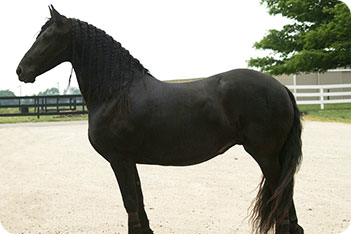
Horseback Riding
Horse Back Flatwork
From: Equestrian and Horse | Horseback Riding
See also: Mounting | Position | Lunging | Jumping
Dismounting | Rider Aids| Dressage Training

Flatwork - Paces
Walk
The walk is the most basic movement of a horse in flatwork. The different types of walk are collected walk, medium walk, extended walk and free walk on a long rein.
More About Riding The Walk
Trotting
The next pace up from walking is trotting. This is a two time rhythm which means that the horse moves its legs in diagonal pairs, for example when the near hind and off fore are elevated off the ground, the off hind and near fore will be on the ground supporting the horse and propelling them forwards. Types of trot are
working trot, collected trot, medium trot and extended trot.
More About Riding The Trot
Canter
The next pace up from trot is canter. This is a three time movement which has a moment of suspension in between each canter stride. The horse can be on one of two canter leads depending on which rein they are on. On the left rein the horse will pick up left lead canter, this is where the horses off hind strikes off first followed by the near hind and off fore together and the near fore being the last footfall to go down. The different types of canter are working canter, collected canter, medium canter and extended canter.
More About Riding The Canter
Turning Your Horse
In order to make a change of direction it is essential that the correct aids are used so that both horse and rider remain in balance before, during and after the turn has been made.
More About Riding A Turn
Changes Of Rein
In any schooling session, several changes of rein are required. A change of rein is where a complete change of direction occurs. This helps to keep the horse supple on both sides as well as preventing boredom. There are seven official changes of rein, which when ridden correctly will allow the horse and rider to smoothly change the direction in balance and harmony.
More About Riding Changes Of Rein
Circle
A circle is a continuous curve where the horse has inside bend and impulsion and fluency throughout. The three main sizes of circle, that are used when schooling or in competition are the 10 meter, 15 meter and 20 meter circle. When schooling they can be ridden anywhere in the school where space allows.
More About Riding Circles
Dressage Training
Training the horse to maintain balance when riding different school movements takes a great deal of time and patience to get right exercises such as Leg Yield, Shoulder In, Travers, Half Pass, Piaffe, Passage, Pirouette and Flying Changes are all Dressage movements that require the horse to maintain balance, lightness of the forehand, elasticity and elegance.
More About Dressage Training
HorseBack Riding Terminology
There are many technical terms used in the art of dressage and all forms of horseback riding, being able to understand them can only help to improve your riding and also help you to understand and improve your horses way of going.
More About Horseback Riding Terminology